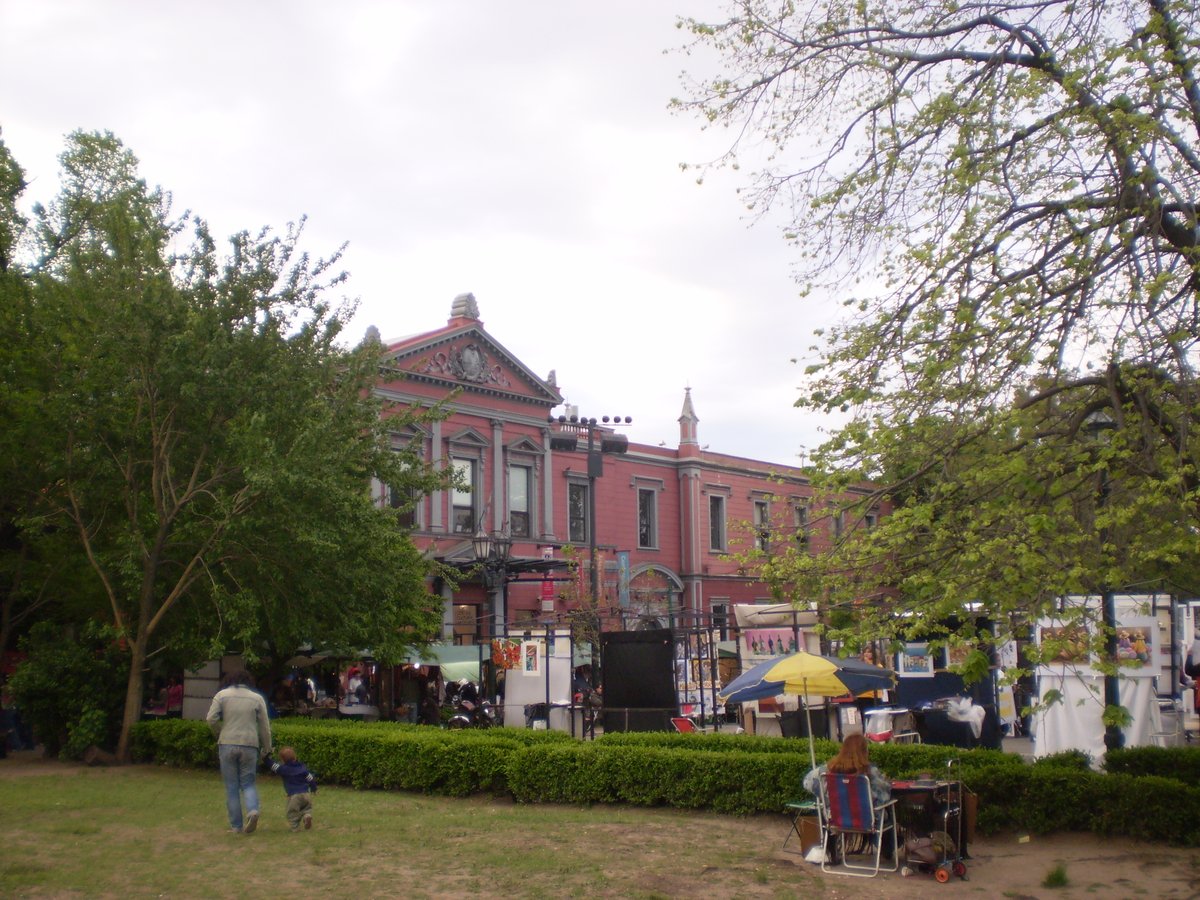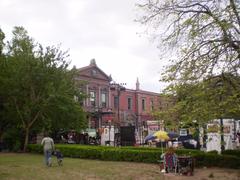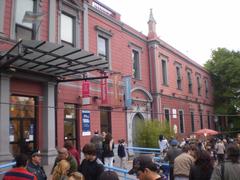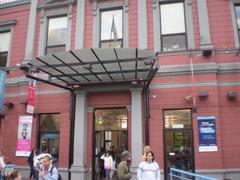
Recoleta Cultural Center: Visiting Hours, Tickets, and the Ultimate Guide to Buenos Aires’ Historical and Cultural Heart
Date: 14/06/2025
Introduction
The Recoleta Cultural Center (Centro Cultural Recoleta, CCR) stands as one of Buenos Aires’ most celebrated cultural landmarks. Nestled in the prestigious Recoleta neighborhood, this storied site offers a seamless blend of colonial architecture, modernist innovation, and vibrant artistic programming. Whether you are a history enthusiast, art lover, or simply seeking an immersive local experience, the Recoleta Cultural Center is a must-visit destination. This guide provides everything you need to know about visiting hours, ticketing, accessibility, nearby historical attractions, and tips for making the most of your visit.
Table of Contents
- Introduction
- History and Architectural Evolution
- Architectural Highlights
- Artistic Programming and Cultural Impact
- Visitor Information
- Visitor Experience and Practical Tips
- Nearby Attractions
- Frequently Asked Questions (FAQ)
- Conclusion and Call to Action
- References and Further Reading
History and Architectural Evolution
Origins and Early History
The Recoleta Cultural Center occupies a building first constructed in 1732 as a convent for the Recoleto monks, a Franciscan order whose name is immortalized in the neighborhood itself (Recoleta Cultural Center Official Site). Adjacent to the Basílica Nuestra Señora del Pilar, the convent was a spiritual and social anchor for the area through the 18th and 19th centuries. Its original colonial architecture—characterized by thick masonry walls and understated lines—reflected the era’s functional simplicity.
Adaptive Reuse and Transformation
In the 1820s, secular reforms in Argentina led to the expulsion of religious orders, and the building entered a new phase as it was adapted for civic purposes. Over the next century and a half, the structure served as a hospital, military barracks, shelter, and home for the elderly (Recoleta Cultural Center Official Site). Each transformation added layers to its architectural and social fabric, culminating in a unique fusion of colonial, Italianate, and modernist styles (WikiArquitectura).
Birth of the Cultural Center
In 1980, visionary Argentine architect Clorindo Testa, along with Jacques Bedel and Luis Benedit, led a major renovation that reimagined the building as a multidisciplinary cultural center. Respecting the original cloisters and colonial elements, they introduced bold modernist interventions—concrete forms, glass surfaces, and innovative spatial arrangements—creating a dynamic environment for creativity and community (WikiArquitectura).
Architectural Highlights
Cloisters and Patios
The luminous galleries and interconnected patios, such as the “Patio de los Naranjos” (Orange Tree Courtyard), are a hallmark of the center’s design. The cloisters, once reserved for monastic contemplation, now host rotating contemporary art exhibitions and provide serene gathering spaces with a café and reading areas (WikiArquitectura).
Aleph Auditorium
The former neo-Gothic chapel, now known as the “Aleph” auditorium, accommodates up to 200 people for screenings, concerts, lectures, and literary events. Renovations have preserved the soaring arches and stained glass, while adding modern seating and acoustics (WikiArquitectura).
Terraces and Sculpture Gardens
Terraces overlooking Avenida del Libertador feature a sculpture garden and a striking steel-roofed café. From here, visitors enjoy panoramic views of the Recoleta Cemetery and the Church of Pilar, underscoring the center’s commitment to blending tradition with innovation (WikiArquitectura).
Artistic Programming and Cultural Impact
The Recoleta Cultural Center is renowned for its diverse and inclusive programming. It hosts:
- Visual Arts Exhibitions: Showcasing works by established and emerging Argentine artists.
- Performances: Theater, music, dance, and literary events take place in multiple auditoriums and open-air spaces.
- Workshops and Residencies: Creative classes in painting, photography, writing, and technology; artist-in-residence programs.
- Festivals: Major cultural events like the Buenos Aires International Festival of Independent Cinema (BAFICI).
- Participatory Science Museum: “Museum Forbidden Not to Touch”—an interactive space for children and families (WikiArquitectura).
The center’s mission is to democratize access to the arts, making culture available to all through free or low-cost programming (PowerTraveller). Its inclusive ethos and support for experimental and interdisciplinary work have helped shape Buenos Aires’ reputation as a global creative hub.
Visitor Information
Visiting Hours
- Open: Tuesday to Sunday, 12:00 PM to 8:00 PM
- Closed: Mondays and certain public holidays
- Note: Always check the official website for special event schedules or holiday hours.
Tickets and Entry Fees
- General Admission: Free
- Special Exhibitions/Events: May require tickets; prices are affordable and available online or at the box office.
Accessibility
- Wheelchair Access: Ramps and elevators throughout the building.
- Services: Staff assistance, accessible restrooms, and barrier-free pathways (WikiArquitectura).
Guided Tours
- Availability: Offered periodically; focus on the center’s history, architecture, and exhibitions.
- Booking: Check the website or inquire at the information desk for times and languages.
Special Events and Travel Tips
- Programming: Frequent festivals, workshops, and performances. Plan ahead by reviewing the events calendar.
- Transport: Easily reached by public transit—Subte Line H (Las Heras station), numerous bus routes, taxis, and ride-share.
- Language: Signage is primarily in Spanish; major exhibitions often include English translations. Staff at the information desk generally speak English.
Visitor Experience and Practical Tips
- Best Time to Visit: Weekdays offer a quieter atmosphere for art appreciation; weekends are lively with artisan fairs and outdoor performances.
- Dress Code: Casual and comfortable; smart-casual for evening events.
- Photography: Allowed in most public areas and exhibitions, but check for restrictions on flash or tripods.
- Facilities: Free Wi-Fi, restrooms on each floor, lockers for personal belongings, cafés with indoor/outdoor seating, and a gift shop.
- Safety: Recoleta is a safe neighborhood, but stay attentive during crowded events.
Nearby Attractions
- Recoleta Cemetery: World-famous for its elaborate mausoleums and as the resting place of Eva Perón (PlanetWare).
- Basílica Nuestra Señora del Pilar: An 18th-century church adjacent to the center.
- Museo Nacional de Bellas Artes: Argentina’s preeminent fine arts museum.
- Plaza Francia: Site of artisan fairs and outdoor performances.
- Floralis Genérica: Iconic steel flower sculpture nearby.
- El Ateneo Grand Splendid: A famed bookstore housed in a former theater.
Frequently Asked Questions (FAQ)
Q: What are the Recoleta Cultural Center’s visiting hours?
A: Open Tuesday to Sunday, 12:00 PM to 8:00 PM; closed Mondays.
Q: Is there an entrance fee?
A: General admission is free; special events may require tickets.
Q: Is the center wheelchair accessible?
A: Yes, with ramps, elevators, and accessible restrooms.
Q: Are guided tours available?
A: Yes, periodically; check the official website for schedules.
Q: Can I take photographs inside?
A: Generally yes, but please respect signage and staff instructions.
Q: Which nearby attractions should I also visit?
A: Recoleta Cemetery, Basílica Nuestra Señora del Pilar, Museo Nacional de Bellas Artes, Floralis Genérica, and Plaza Francia.
Conclusion and Call to Action
The Recoleta Cultural Center is more than a historical monument—it’s a living symbol of Buenos Aires’ resilience, creativity, and commitment to accessible culture. Its architectural beauty, diverse programming, and welcoming atmosphere ensure a memorable experience for every visitor. Take time to explore the center, enjoy its exhibitions and events, and discover the cultural riches of the surrounding Recoleta neighborhood.
Plan your visit today:
- Check the official Recoleta Cultural Center website for up-to-date info, event calendars, and virtual tours.
- Download the Audiala app for curated local experiences and guided tours.
- Follow the center’s social media for news and exhibition announcements.
Experience the pulse of Buenos Aires at the Recoleta Cultural Center—where history, community, and creativity converge.
Visuals and Interactive Media Suggestions
- Exterior shot: “Facade of the Recoleta Cultural Center showing colonial and modern architectural elements”
- Interior photo: “Vaulted cloisters inside the Recoleta Cultural Center”
- Event image: “Art exhibition at Recoleta Cultural Center”
- Interactive map: Highlighting the center and surrounding attractions
References and Further Reading
- Recoleta Cultural Center Official Site
- Recoleta Cultural Center and Buenos Aires Design, WikiArquitectura
- Recoleta Buenos Aires: Everything You Need to Know About the Neighborhood, Expat Pathways
- Recoleta: The Belle Époque of Buenos Aires, PowerTraveller
- Recoleta Neighborhood Guide, Gringo in Buenos Aires
- Travel and Itinerary
- Sol Salute
- Nomadic Matt
- PlanetWare
- Centro Cultural Recoleta
- Wanderlog
































































































































































